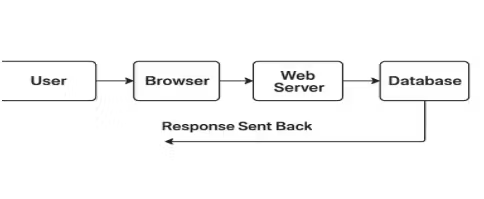Let's Talk
×In 2025, businesses thrive in a digital environment characterized by rapid change. Almost every relationship is powered by technology. Apps you may use online are becoming a must for everyday life. They help with shopping, talking to people, having fun, and getting things done. You could be utilizing a web application without even knowing it. Web apps are a key part of what you do on the internet. They are generally involved when you edit a file, view a movie, or talk to your team.
But what is a web app, exactly? How does it work behind the scenes? What are the benefits of web applications? This blog will explain everything in a simple way, which is great for business owners who want to stay ahead.
What is a Web Application?
Instead of being installed on your computer or phone, a web application runs in a web browser. You don't have to manually download or update anything like you do with traditional desktop apps. You only need a device that can connect to the internet and a browser like Chrome, Safari, or Edge.
Some well-known web apps are Gmail, Google Docs, Trello, Netflix, and Canva. These apps help people get things done that are difficult. You may edit documents, watch movies, or work on projects right in your browser.
Web apps are strong because they are simple to use and can be customized to meet your needs. You can sign in from any computer. You can start right where you left off. You don't have to worry about running out of space or having to upgrade your program.
How does a web application work?
Every time you click on a web app, a complicated procedure happens in milliseconds. By knowing this cycle, businesses may better assess how strong web apps are.
Here is a short selection of things to do:
1. User Interaction (Front-End)
When a user interacts with the interface, the procedure starts. You can do this by filling out a form, clicking a button, or going through options. The front-end layer is made up of HTML, CSS, and JavaScript frameworks like React, Angular, and Vue.js.
2. Request sent to the server
The browser asks the web server for help when a user performs something. The server is like the brain because it tells the system what to do next.
3. Server Talks to the Database (Back-End)
The server handles the request and, if needed, gets or changes data in a database such as MySQL or MongoDB.
4. Response sent back to the browser
The front end updates right away after the server responds. It shows new content, confirms actions, or loads dashboards.

Types of Web Applications
There are different ways to make web apps. These are the primary types of web applications that will be available in 2025:
1. Static Web Application
These are the simplest. They have fixed content and don't let you interact with it very much. They're good for simple informational web pages, brochures, and portfolios.
2. Dynamic Web Application
As you use them, dynamic apps make content. When people utilize social networking sites and blogs, they alter it right away.
3. E-Commerce Web Application
Two fantastic examples of internet stores are Shopify and Amazon. They handle everything in the browser, from shopping carts and product catalogs to payment gateways.
4. Progressive Web Applications (PWAs)
PWAs are the best of both worlds because they are like web pages and mobile apps. They load quickly, work offline, and send you push notifications. Starbucks and Twitter both employ PWAs. This lets people utilize their apps without having to download them.
5. SaaS (Software-as-a-Service) applications
You pay for SaaS web programs every month, and they are stored in the cloud. They are great for businesses. Canva, Slack, and Zoom are some of the most popular apps that help businesses grow.
Benefits of Using Web Application in 2025
Why are so many companies moving to web apps in 2025? It's evident what the benefits of web application are:
1. Access from Any Device
Web programs run in browsers. This implies that they work on PCs, tablets, and phones. You don't have to put them on your computer.
2. Affordable and Scalable
Web apps make infrastructure costs lower. Scaling up usually implies adding more resources to the cloud. It doesn't need any new hardware.
3. Easy maintenance and updates
Updates come from the server. Everyone gets the latest version right away. They don’t need to update it on their own.
4. Cloud Integration and Automation
Cloud services integrate well with modern online apps, and they also make workflows faster and easier.
Technologies Used in Modern Web Application Development
Web app development 2025 leverages cutting-edge techniques and technologies. These web development technologies and tools help make apps that are faster, safer, and easier to grow.
Front end:
- React.js is fast and works well for user interfaces that need to be interactive.
- Angular is a great way to make business apps that are simple to use.
- Vue.js is light and adaptable.
Back-End:
- Node.js is a great choice for applications that need to grow and work in real-time.
- If you need to think a lot, Python (Django, Flask) is a fantastic choice.
- If you need your projects to be safe and dependable, PHP (Laravel) is a good choice.
Databases:
- MongoDB (NoSQL) for freedom.
- MySQL (SQL) sorts structured data.
Platforms for Development:
- For hosting and scaling, AWS, Azure, and Firebase are the best.
Many web apps will incorporate AI, automation, and Progressive Web Apps (PWAs) by 2025. AI is making personalization, security, and data analysis better than ever before.
Web Application Examples and Case Studies
- Web apps are quite prominent digital platforms right now.
- People from all over the world can work together on Google Docs in real time without having to install anything.
- The Netflix app has movies and TV shows that are developed exclusively for millions of people to view.
- Shopify lets businesses set up and run online stores without needing to know how to code.
These examples show that web apps may be speedy, versatile, and easy to use while still solving genuine problems.
FAQ's
What is the main purpose of a web application?
The basic goal of a web app is to let consumers utilize a browser to access services and features that are interactive. This way, they don't have to download anything to their devices. They simplify access to information, reduce tech barriers, and help businesses provide clients worldwide with real-time updates and smooth performance.
2. What sets web apps apart from mobile apps?
Web apps work on any device that has an internet connection and a browser. App stores are the only places where you can get mobile apps, and they usually only work on one platform, like iOS or Android. Updating web apps is easier. Mobile apps, on the other hand, can use more of the device's features, like the camera and GPS.
3.Are web applications secure in 2025?
Modern apps use HTTPS, encryption, and firewalls to protect user data. They also get regular updates that make them safer. To lower risks, developers stick to strict best practices. They look at the input and use more than one method to confirm your identity. There is no such thing as a completely safe system, but web apps are significantly safer now than they were in the past.
4. Can web apps help small businesses?
Yes. Web apps make it easier for small businesses to work. They spend less on software and make their clients' online experiences better. Small businesses may use the same powerful technology that big enterprises do, thanks to web apps. This includes tools for making reservations, e-commerce sites, and use within the company.
The Future Belongs to Web Applications
It's no longer enough to just have web apps; you need them. Web apps help many kinds of businesses grow, from small to large. They assist you in keeping ahead of the competition and coming up with innovative ideas.
Want to design a web app for your business that is sturdy and flexible? Contact DigiExpo, your reliable web development partner in Dubai. DigiExpo can make your business better starting in 2025 and beyond. We can help you with everything from a customer portal to an internal tool to a SaaS platform.

